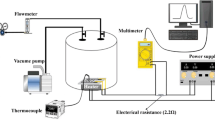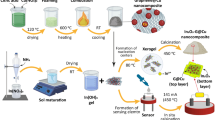Abstract
This paper demonstrated a high-performance hydrogen gas sensor based on CuO–reduced graphene oxide (rGO)–CuO sandwiched nanostructure. The CuO–rGO–CuO nanostructure was examined by scanning electron microscopy, X-ray diffraction and transmission electron microscope. The gas sensing characteristics of the CuO–rGO–CuO film sensor were evaluated at room temperature against hydrogen over a wide concentration range, which are better than that of pristine CuO and rGO. High sensitivity, good repeatability, and response–recovery characteristics were achieved in this work. Furthermore, the possible sensing mechanism of the presented sensor was explored.









Similar content being viewed by others
References
P.A. Pandey, N.R. Wilson, J.A. Covington, Pd-doped reduced graphene oxide sensing films for H2 detection. Sens. Actuators B Chem. 183, 478–487 (2013)
J. Hong, S. Lee, J. Seo, S. Pyo, J. Kim, T. Lee, A highly sensitive hydrogen sensor with gas selectivity using a PMMA membrane-coated Pd nanoparticle/single-layer graphene hybrid. ACS Appl. Mater. Interfaces 7, 3554–3561 (2015)
D. Dutta, S.K. Hazra, J. Das, C.K. Sarkar, S. Basu, Studies on p-TiO2/n-graphene heterojunction for hydrogen detection. Sens. Actuators B Chem. 212, 84–92 (2015)
Y. Lim, Y. Lee, J. Heo, H. Shin, Highly sensitive hydrogen gas sensor based on a suspended palladium/carbon nanowire fabricated via batch microfabrication processes. Sens. Actuators B Chem. 210, 218–224 (2015)
Y.R. Wang, B. Liu, S.H. Xiao, H. Li, L.L. Wang, D.P. Cai, D.D. Wang, Y. Liu, Q.H. Li, T.H. Wang, High performance and negative temperature coefficient of low temperature hydrogen gas sensors using palladium decorated tungsten oxide. J. Mater. Chem. A 3, 1317–1324 (2015)
M. Darabpour, M. Doroodmand, Fabrication of a glow discharge plasma-based ionization gas sensor using multiwalled carbon nanotubes for specific detection of hydrogen at parts per billion levels. IEEE Sens. J. 15, 2391–2398 (2015)
B. Wang, Z.Q. Zheng, L.F. Zhu, Y.H. Yang, H.Y. Wu, Self-assembled and Pd decorated Zn2SnO4/ZnO wire-sheet shape nano-heterostructures networks hydrogen gas sensors. Sens. Actuators B Chem. 195, 549–561 (2014)
R. Abkadir, Z.Y. Li, A. Sadek, R. Abdulrani, A. Zoolfakar, M. Field, J.Z. Qu, A. Chrimes, K. Kalantar-Zadeh, Electrospun granular hollow SnO2 nanofibers hydrogen gas sensors operating at low temperatures. J. Phys. Chem. C 118, 3129–3139 (2014)
B. Mondal, B. Basumatari, J. Das, C. Roychaudhury, H. Saha, N. Mukherjee, ZnO–SnO2 based composite type gas sensor for selective hydrogen sensing. Sens. Actuators B Chem. 194, 389–396 (2014)
D. Jung, M. Han, G.S. Lee, Gas sensor using a multi-walled carbon nanotube sheet to detect hydrogen molecules. Sens. Actuators A Phys. 211, 51–54 (2014)
E. Christine, B. Peter, W. Friedrich, S. Torsten, Multi- component trace analysis of organic xenobiotics in surface water containing suspended particular matter by solid phase extraction/gas chromatography-mass spectrometry. J. Chromatogr. A 1249, 181–189 (2012)
C.H. Wang, S.W. Chiang, J.L. Wang, Simultaneous analysis of atmospheric halocarbons and non-methane hydrocarbons using two-dimensional gas chromatography. J. Chromatogr. A 3, 353–358 (2010)
A. Grossel, V. Zéninari, B. Parvitte, L. Joly, D. Courtois, Optimization of a compact photoacoustic quantum cascade laser spectrometer for atmospheric flux measurements: application to the detection of methane and nitrous oxide. Appl. Phys. B 88, 483–492 (2007)
B. Mortazavi, B.J. Wilson, F. Dong, M. Gupta, D. Baer, Validation and application of cavity-enhanced, near-infrared tunable diode laser absorption spectrometry for measurements of methane carbon isotopes at ambient concentrations. Environ. Sci. Technol. 47, 11676–11684 (2013)
H. Abdul, B.C. Morat, R. Abdul, Non-invasive evaluation of hydrogen peroxide concentrations in a drinking bottle by near-infrared spectrometry. Sens. Transducers 131, 83–90 (2011)
D. Zhang, A. Liu, H. Chang, B. Xia, Room-temperature high-performance acetone gas sensor based on hydrothermal synthesized SnO2-reduced graphene oxide hybrid composite. RSC Adv. 5, 3016–3022 (2015)
C. Liewhiran, N. Tamaekong, A. Wisitsoraat, A. Tuantranont, S. Phanichphant, Ultra-sensitive H2 sensors based on flame-spray-made Pd-loaded SnO2 sensing films. Sens. Actuators B Chem. 176, 893–905 (2013)
D. Zhang, H. Chang, P. Li, R. Liu, Characterization of nickel oxide decroated-reduced graphene oxide nanocomposite and its sensing properties toward methane gas detection. J. Mater. Sci. Mater. Electron. 27, 3723–3730 (2016)
F. Bayata, B. Saruhan-Brings, M. Ürgen, Hydrogen gas sensing properties of nanoporous Al-doped titania. Sens. Actuators B Chem. 204, 109–118 (2014)
D. Zhang, N. Yin, B. Xia, Y. Sun, Y. Liao, Z. He, S. Hao, Humidity-sensing properties of hierarchical ZnO/MWCNTs/ZnO nanocomposite film sensor based on electrostatic layer-by-layer self-assembly. J. Mater. Sci. Mater. Electron. 27, 2481–2487 (2016)
C. Zhang, A. Boudiba, C. Navio, C. Bittencourt, M.G. Olivier, R. Snyders, M. Debliquy, Highly sensitive hydrogen sensors based on co-sputtered platinum activated tungsten oxide films. Int. J. Hydrog. Energy 36, 1107–1114 (2011)
M. Sanhita, N. Pratanu, S.D. Parukuttyamma, Enhanced performance of CNT/SnO2 thick film gas sensors towards hydrogen. Mater. Chem. Phys. 147, 79–85 (2014)
A. Kanika, S. Onkar, P.S. Manmeet, Hydrogen sensor based on graphene/ZnO nanocomposite. Sens. Actuators B Chem. 195, 409–415 (2014)
K. Zhou, R. Wang, B. Xu, Y. Li, Synthesis, characterization and catalytic properties of CuO nanocrystals with various shapes. Nanotechnology 17, 3939–3943 (2006)
L.B. Chen, N. Lu, C.M. Xu, H.C. Yu, T.H. Wang, Electrochemical performance of polycrystalline CuO nanowires as anode material for Li ion batteries. Electrochim. Acta 54, 4198–4201 (2009)
Y.W. Zhu, T. Yu, F.C. Cheong, X.J. Xu, C.T. Lim, V.B.C. Tan, J.T.L. Thong, C.H. Sow, Large-scale synthesis and field emission properties of vertically oriented CuO nanowire films. Nanotechnology 16, 88–92 (2005)
J. Zhang, J. Liu, Q. Peng, X. Wang, Y. Li, Nearly monodisperse Cu2O and CuO nanospheres: preparation and applications for sensitive gas sensors. Chem. Mater. 18, 867–871 (2006)
H.J. Park, N.J. Choi, H. Kang, M.Y. Jung, J.W. Park, K.H. Park, D.S. Lee, A ppb-level formaldehyde gas sensor based on CuO nanocubes prepared using a polyol process. Sens. Actuators B Chem. 203, 282–288 (2014)
A. Taubert, F. Stange, Z.H. Li, M. Junginger, C. Gunter, M. Neumann, A. Friedrich, CuO nanoparticles from the strongly hydrated ionic liquid precursor (ILP) tetrabutyl ammonium hydroxide: evaluation of the ethanol sensing activity. ACS Appl. Mater. Interfaces 4, 791–795 (2012)
S. Steinhauer, E. Brunet, T. Maier, G.C. Mutinati, A. Kock, Suspended CuO nanowires for ppb level H2S sensing in dry and humid atmosphere. Sens. Actuators B Chem. 186, 550–556 (2013)
D. Zhang, H. Chang, P. Li, R. Liu, Q. Xue, Fabrication and characterization of an ultra-sensitive humidity sensor based on metal oxide/graphene hybrid nanocomposite. Sens. Actuators B Chem. 225, 233–240 (2016)
R. Furue, E.P. Koveke, S. Sugimoto, Y. Shudo, S. Hayami, S.I. Ohira, K. Toda, Arsine gas sensor based on gold-modified reduced graphene oxide. Sens. Actuators B Chem. 240, 657–663 (2017)
D. Zhang, J. Tong, B. Xia, Q. Xue, Ultrahigh performance humidity sensor based on layer-by-layer self-assembly of graphene oxide/polyelectrolyte nanocomposite film. Sens. Actuators B Chem. 203, 263–270 (2014)
D. Zhang, J. Tong, B. Xia, Humidity-sensing properties of chemically reduced graphene oxide/polymer nanocomposite film sensor based on layer-by-layer nano self-assembly. Sens. Actuators B Chem. 197, 66–72 (2014)
Y. Kwon, H. Kim, S. Lee, I.J. Chin, T.Y. Seong, W.I. Lee, C. Lee, Enhanced ethanol sensing properties of TiO2 nanotube sensors. Sens. Actuators B Chem. 173, 441–446 (2012)
D.H. Nguyen, Y.A. Sea, Q.D. Nguyen, V.Q. Nguyen, K. Dojin, Synthesis of p-type semiconducting cupric oxide thin films and their application to hydrogen detection. Sens. Actuators B Chem. 146, 239–244 (2010)
Z. Zhang, X. Zou, L. Xu, L. Liao, W. Liu, J. Ho, X. Xiao, C. Jiang, J. Li, Hydrogen gas sensor based on metal oxide nanoparticles decorated graphene transistor. Nanoscale 7, 10078–10084 (2015)
I.H. Kadhim, H.A. Hassan, Room temperature hydrogen gas sensor based on nanocrystalline SnO2 thin film using sol–gel spin coating technique. J. Mater. Sci. Mater. Electron. 27, 4356–4362 (2016)
Acknowledgments
This work was supported by the National Natural Science Foundation of China (Grant No. 51407200), the Science and Technology Plan Project of Shandong Province (Grant No. 2014GSF117035), the Fundamental Research Funds for the Central Universities of China (No. 15CX05041A), and the Science and Technology Project of Huangdao Zone, Qingdao, China (No. 2014-1-51).
Author information
Authors and Affiliations
Corresponding author
Ethics declarations
Conflict of interest
The authors declared that they have no conflicts of interest to this work.
Rights and permissions
About this article
Cite this article
Zhang, D., Yin, N., Jiang, C. et al. Characterization of CuO–reduced graphene oxide sandwiched nanostructure and its hydrogen sensing characteristics. J Mater Sci: Mater Electron 28, 2763–2768 (2017). https://doi.org/10.1007/s10854-016-5856-8
Received:
Accepted:
Published:
Issue Date:
DOI: https://doi.org/10.1007/s10854-016-5856-8




